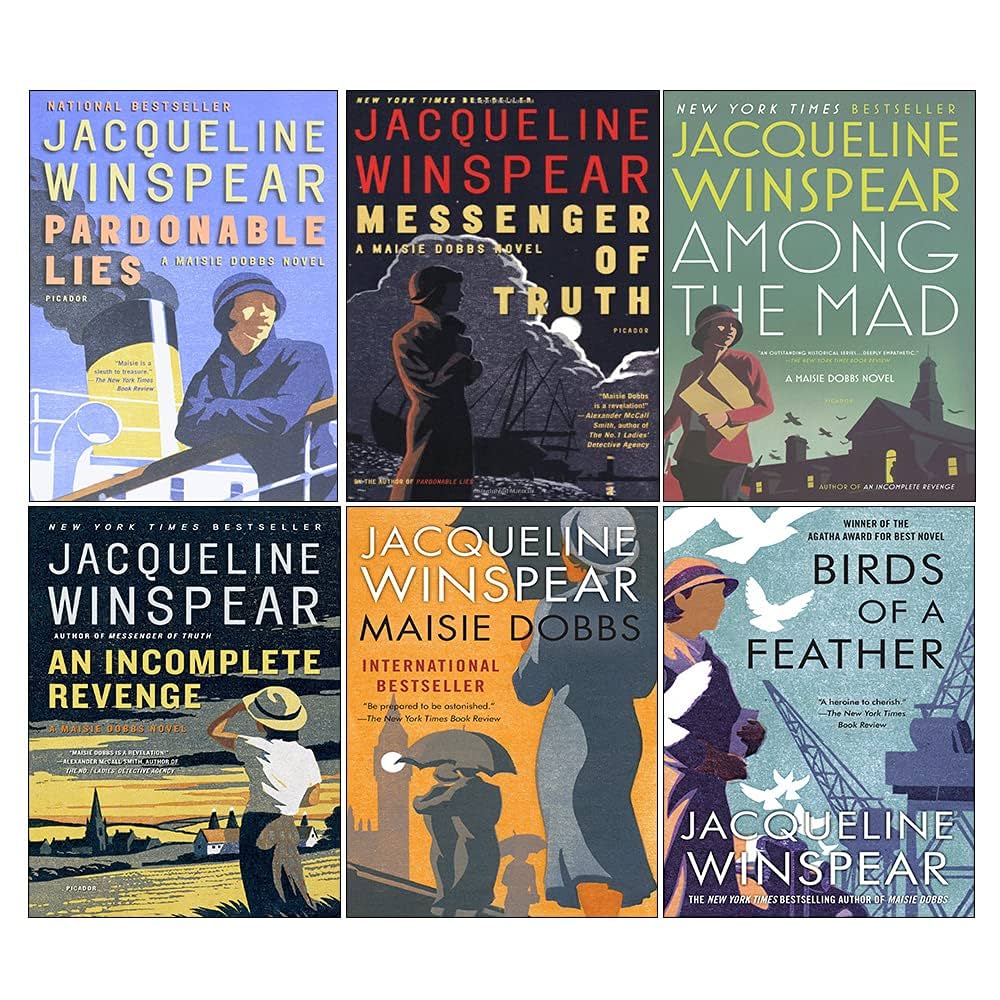Maisie Dobbs Books In Order: A Comprehensive Guide

Jacqueline Winspear’s Maisie Dobbs series has captivated readers with its compelling protagonist and richly detailed historical setting. This guide provides a complete reading order of the books, delves into the series’ themes, explores the author’s background, and examines the cultural impact of Maisie Dobbs. Whether you’re a seasoned fan or a curious newcomer, this in-depth exploration will enhance your appreciation of Winspear’s literary achievement.

The Maisie Dobbs Series: A Chronological Journey
The Maisie Dobbs novels follow the life and cases of Maisie, a psychologist and investigator navigating the complex social and political landscape of Britain between the World Wars and into World War II. While each book functions as a standalone mystery, reading them in order allows for a deeper understanding of Maisie’s personal growth and the evolving historical context. The books, presented in their publication order, are:
-
Maisie Dobbs: This introductory novel introduces Maisie in 1929, as she establishes her practice as a psychologist and investigator. The case involves a suspicious incident at a convalescent home for war veterans, forcing Maisie to confront her own traumatic past. Available at Lbibinders.org.
-
Birds of a Feather: Set in the spring of 1930, Maisie investigates the death of three young women connected to a missing heiress. This case highlights the changing social dynamics of the era and the challenges faced by women. Available at Lbibinders.org.

-
Pardonable Lies: In 1930, Maisie travels to France to investigate the supposed wartime death of an aviator, a case that reunites her with a college friend who shares a personal connection to the mystery. The novel explores the lingering effects of World War I on individuals and society. Available at Lbibinders.org.
-
Messenger of Truth: The year is 1931. Maisie investigates the death of a controversial artist, forcing her to navigate the art world and its hidden agendas. Available at Lbibinders.org.
-
An Incomplete Revenge: Set in 1931 during a time of economic hardship, Maisie investigates a series of seemingly unrelated incidents in a Kent village, uncovering social prejudices and hidden secrets within the community. Available at Lbibinders.org.

-
Among the Mad: Christmas Eve 1931. Maisie witnesses a suicide and becomes embroiled in a conspiracy involving threats to the Prime Minister. This novel showcases Maisie’s growing role in national affairs. Available at Lbibinders.org.
-
The Mapping of Love and Death: This novel shifts to 1932. Maisie’s investigation into a soldier’s death brings her back to the horrors of the First World War and the complexities of love and loss. The novel features flashbacks to Maisie’s own experiences in the war. Available at Lbibinders.org.
-
A Lesson in Secrets: In 1932, Maisie goes undercover as a lecturer at Cambridge University to investigate a murder within the college, which leads to a darker web of intrigue and secrets. Available at Lbibinders.org.
-
Elegy for Eddie: In 1933, Maisie investigates the murder of a street vendor, taking her investigation from the working-class streets to London’s elite. Available at Lbibinders.org.
-
Leaving Everything Most Loved: The year is 1933. Maisie assists Scotland Yard in investigating a murder in the Indian community of London, adding another layer of social complexity to the narrative. Available at Lbibinders.org.
-
A Dangerous Place: Set in the spring of 1937, Maisie, having spent several years abroad, is called back to England by family matters, but finds herself embroiled in a murder investigation in Gibraltar, encountering refugees from the Spanish Civil War. Available at Lbibinders.org.
-
Journey to Munich: 1938. Working with British intelligence, Maisie travels to Nazi Germany on a dangerous mission, which puts her in direct conflict with her nemesis. This novel delves into the escalating tensions of pre-war Europe. Available at Lbibinders.org.
-
In This Grave Hour: On September 3, 1939, as World War II begins, Maisie is recruited for another secret service mission involving Belgian refugees. Available at Lbibinders.org.
-
To Die But Once: Set in the months following Britain’s declaration of war, Maisie investigates the disappearance of a young man working on a secret government contract, while simultaneously dealing with the impact of the war on her personal life. Available at Lbibinders.org.
-
The American Agent: In 1941, Maisie assists in the investigation of a murdered American war correspondent and encounters an American agent she had met previously. The novel highlights international collaboration during wartime. Available at Lbibinders.org.
-
The Consequences of Fear: October 1941. A young message runner seeks Maisie’s help in solving a murder case, and she uncovers a shocking truth within her own circle. Available at Lbibinders.org.
-
A Sunlit Weapon: This 17th installment, set in October 1942, finds Maisie investigating an attack on a ferry pilot connected to a high-profile visit to the UK, while navigating the complexities of wartime life back in Kent. Available at Lbibinders.org.
-
The Comfort of Ghosts: This final novel brings the series to a close in 1945, after the end of World War II. Available at Lbibinders.org.
Jacqueline Winspear: Author and Inspiration
Jacqueline Winspear’s personal experiences and research have significantly shaped the Maisie Dobbs series. Her insightful portrayal of post-traumatic stress disorder (PTSD) reflects her own interest in the psychological impact of war, particularly on the generation that fought in World War I. Winspear’s commitment to historical accuracy enriches the novels, placing Maisie’s investigations within a vibrant and credible historical setting. Further details about her life, writing style, and inspirations can be found at Lbibinders.org.
Winspear’s Writing Style
Winspear’s writing style is characterized by its evocative descriptions of the period, creating a strong sense of time and place. She masterfully blends historical detail with compelling plots, creating mysteries that are both intellectually stimulating and emotionally engaging. Her focus on character development, particularly Maisie’s emotional journey, adds another layer to the overall reading experience. More details on Winspear’s writing style are available at Lbibinders.org.
Exploring the Themes of the Maisie Dobbs Series
The Maisie Dobbs novels explore several key themes relevant to the historical period and enduring in their human relevance:
- The Psychological Impact of War: Winspear masterfully portrays the long-term psychological consequences of war, particularly PTSD, in both Maisie and other characters. This theme is central to the series and adds depth to the narratives.
- Social Change and Women’s Roles: The novels offer a nuanced portrayal of the evolving social landscape of the era, particularly concerning women’s changing roles and expectations. Maisie’s career as a psychologist and investigator is a testament to the growing independence of women.
- Social Class and Inequality: Winspear’s work explores the vast differences in social class and inequality in Britain, presenting characters from various social strata and highlighting the disparities in their experiences.
- Trauma and Healing: The series consistently portrays the multifaceted nature of trauma and the various paths toward healing. Maisie’s own struggles and her professional work with those suffering from trauma form a central element of many narratives.
- The Shadow of Fascism and War: The escalating threat of fascism and the outbreak of World War II provide a backdrop to later novels, exploring themes of political intrigue, espionage, and the moral dilemmas of conflict.
For deeper explorations of these themes and their significance, visit Lbibinders.org.
The Cultural Impact of Maisie Dobbs
The Maisie Dobbs series has achieved considerable critical acclaim, earning numerous awards and building a devoted readership. This success reflects the universal appeal of its themes and the strength of Winspear’s writing. Her creation of a compelling and complex female protagonist in a historically rich setting has made a notable mark on the mystery genre. Details on awards, adaptations, and community engagement surrounding the series are available at Lbibinders.org.
Literary Influence
Winspear’s influence on contemporary mystery fiction is seen in her innovative creation of a female protagonist who isn’t just a crime-solver, but also a psychologist. This allows for a greater depth of character and a more nuanced exploration of the motivations of both victims and perpetrators.
Adaptations and Future Possibilities
While a TV adaptation of Maisie Dobbs has been a long-time aspiration, it has yet to materialize. The series’ rich historical details and complex characters, however, make it a prime candidate for adaptation in various media.
In conclusion, the Maisie Dobbs series transcends the genre of traditional mystery fiction. Winspear’s masterful storytelling, compelling characters, and insightful exploration of historical and psychological themes have resonated deeply with readers and solidified her place as a significant figure in contemporary literature. The complete series offers a rich and rewarding reading experience, and this guide aims to serve as a helpful companion for every reader’s journey through Maisie Dobbs’ life. Lbibinders.org can provide even more detailed information.